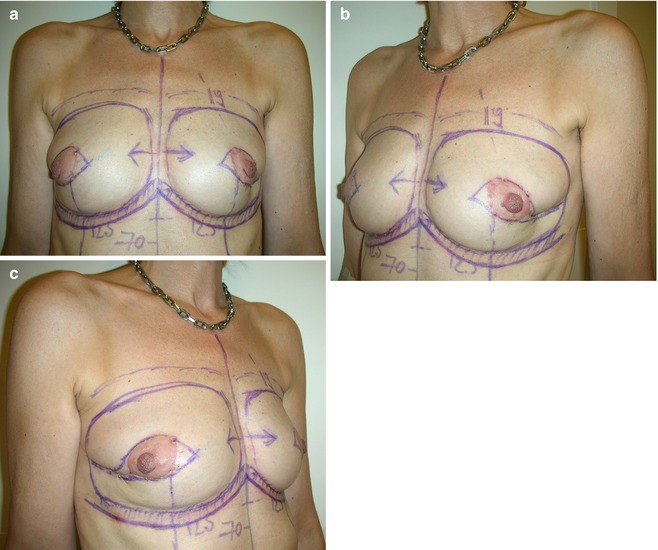Fig. 34.1
Preoperative view. The 49-year-old patient was scheduled for a quadrantectomy (B plasty) for invasive cancer of the left breast and excision of a fibroadenoma of the right breast
Reoperation surgery was done with wide re-excisions on the left breast and a B plasty quadrantectomy on the right breast.
Histology of both specimens again revealed involved margins. Due to a positive family history (no mutation defect found in genetic testing), an otherwise unsuspicious mammogram (no microcalcifications, no masses in the radiological examinations), and a poor cosmetic outcome after bilateral quadrantectomy and re-excision, the patient decided for a bilateral mastectomy and immediate reconstruction with implants. Following multiple previous surgeries, the patient revealed two small non-ptotic breasts with scars from the B plasties (Fig. 34.2a–c).


Fig. 34.2
(a–c) Following B plasty and re-excision on the left breast and tumorectomy and B plasty for incidentally found cancer on the right breast, the patients showed small non-ptotic breasts with scars after bilateral B plasties. A tissue deficit was seen in the lateral quadrants of both breasts with the nipple position too far laterally. Drawings were made for bilateral skin-sparing mastectomy and immediate reconstruction with implants
34.2 Surgery
A bilateral skin-sparing mastectomy was performed. The resection of the nipple-areola complex (NAC) was done due to the preference of the patient, the extensive intraductal carcinoma, and the uncertain blood supply of the NAC when a nipple-sparing mastectomy is performed after a B plasty. Sentinel node biopsy found two nodes in each breast, which were negative in the frozen-section examination. Immediate reconstruction was done with 250 cc anatomical implants inserted in the subpectoral pocket (Fig. 34.3a, b




Stay updated, free articles. Join our Telegram channel

Full access? Get Clinical Tree








